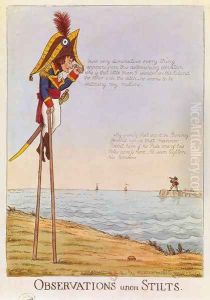Piercy Roberts Paintings
Piercy Roberts was a British printmaker, publisher, and painter, active during the late 18th and early 19th centuries. While the exact date of his birth is not confirmed, it is generally believed he was born around 1758. Roberts is best known for his satirical prints, which reflect the political and social atmosphere of his time. His career as an artist and publisher was particularly active during the 1780s and the early decades of the 1800s.
Roberts operated in London, where he both created and sold his works. He was part of a vibrant community of printmakers, which included the likes of James Gillray and Thomas Rowlandson, whose works were popular and widely disseminated. Roberts' print shop was located at 28 Middle Row, Holborn, before he moved it to 2 Middle Row by 1810. His establishment was a center for the production and distribution of satirical prints and other forms of graphic art, which were an important medium for public discourse and critique at the time.
The subject matter of Roberts' satirical prints was diverse, including political events, social scandals, and commentary on everyday life. His works often featured caricatures of public figures and were characterized by their humor and sharp wit. This period was a golden age for British satire, in part because of the absence of strict censorship laws that would later be imposed. Roberts' contribution to this genre of art was significant, and his prints provide valuable insight into the cultural and political landscape of the period.
Not much is documented about Roberts' personal life or his training as an artist. However, his work reveals a skilled hand and an eye for detail and composition. The visual language of satire required a keen sense of observation and the ability to distill complex ideas into engaging imagery, a talent that Roberts undoubtedly possessed.
The last known records of Roberts' activity date to around 1831, after which there is little information. The year of his death is not clearly documented, leaving a gap in the understanding of his later life and the end of his career. Despite this, Roberts' contributions to British printmaking and the art of satire remain noteworthy, and his prints continue to be studied and appreciated for their historical and artistic value.
